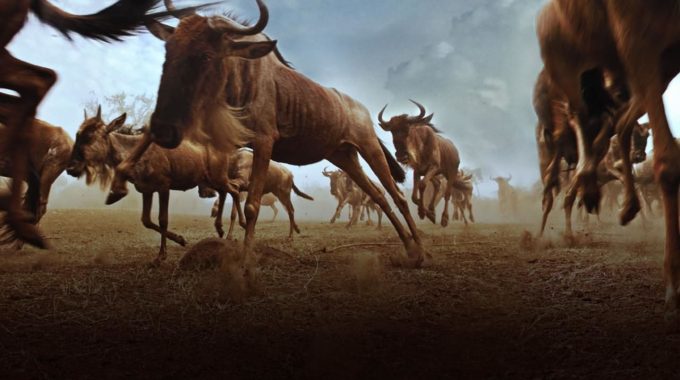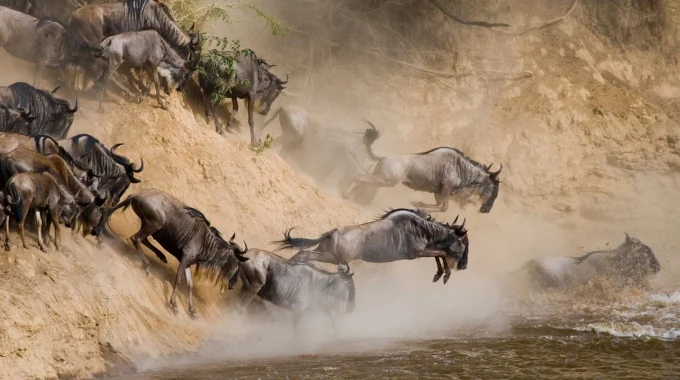Zanzibar, an exotic island paradise in the Indian Ocean, is a dream destination for many…
When to see the Great Migration in Tanzania?

When to see the Great Migration in Tanzania? – In Tanzania, the Great Wildebeest Migration is most commonly observed in the Serengeti National Park, and the timing of the migration depends largely on the seasonal rainfall and the availability of fresh grazing. Here’s when to visit Tanzania for the best experiences of the Great Migration:
-
Southern Serengeti (January to March) – Calving Season
- When to go: January to March
- Where: Southern Serengeti (specifically the Ndutu area, near the Ngorongoro Conservation Area)
- What to expect: The migration starts in the southern Serengeti, where over 500,000 wildebeest give birth in the lush, nutrient-rich grasslands. This is the calving season, and it’s one of the most spectacular times to visit. It’s not just about the wildebeests—this is also prime predator territory, so you’ll have a chance to see lions, cheetahs, and hyenas hunting newborn calves.
- Why go: The calving season is a prime time for wildlife action, with many newborns attracting predators. The landscape is also beautiful, with wide open plains and the first rains turning the area lush and green.
-
Central Serengeti (April to May) – Grazing & Moving North
- When to go: April to May
- Where: Central Serengeti and Western Serengeti
- What to expect: After the calving season, the herds begin moving northward in search of fresh grazing. You’ll see the wildebeest herds moving across the Serengeti’s central region. While the rains are still falling, the herds are spread out, grazing on the tall grasses. The weather is more unpredictable, with potential rain showers.
- Why go: This is a quieter time in terms of tourism, so you can experience the migration in a more peaceful, less crowded environment. However, the rains can make some areas more challenging to access.
-
Western Serengeti (June to July) – River Crossings Begin
- When to go: June to July
- Where: Western Serengeti, especially around the Grumeti River
- What to expect: By mid-year, the wildebeests are starting to head towards the western corridor of the Serengeti, where they will face the Grumeti River crossing. While not as dramatic as the Mara River crossing, the Grumeti River is a key challenge for the migrating herds, and watching them attempt to cross this river can be very exciting.
- Why go: If you’re aiming for the river crossings but don’t want to be in Kenya’s Maasai Mara, this is your best time to witness the migration. The Grumeti River crossings (usually in June and July) are a spectacular sight, though they can be less crowded than the Mara River crossings in Kenya.
-
Northern Serengeti & Mara River Crossings (July to October)
- When to go: July to October
- Where: Northern Serengeti (near the Mara River), close to the border with Kenya
- What to expect: From July to October, the wildebeests arrive in the northern part of the Serengeti, where they will face the Mara River crossing (which is close to the border with Kenya). This is the peak of the Great Migration and the most dramatic period, as the herds attempt to cross the river to reach the Maasai Mara in Kenya. The crossings are an adrenaline-packed event, often accompanied by crocodile attacks, with some wildebeests making it across and others falling prey to predators. It’s one of the most famous wildlife events in the world.
- Why go: This is the most dramatic time to witness the migration, especially the Mara River crossings, which are a highlight of the Great Migration. However, it can also be the most crowded, especially in popular spots along the Mara River.
-
Returning South (October to December) – The Return Journey
- When to go: October to December
- Where: Northern Serengeti, returning southward to the southern Serengeti
- What to expect: After spending the dry season in the northern Serengeti and Maasai Mara, the wildebeests begin to move back south towards the Serengeti’s southern plains, where they started the cycle earlier in the year. The herds will be following the rains, looking for fresh grazing land.
- Why go: If you’re looking for a quieter time to witness the migration as the crowds thin out, this period can be ideal. The return journey is not as dramatic as the Mara River crossings, but you can still see large herds moving south.
Best Overall Time to See the Migration in Tanzania
- For River Crossings & Dramatic Action: If you’re specifically looking to see the Mara River crossings (the iconic crossing with crocodiles), the best time to visit Tanzania is from July to October, when the migration reaches the northern Serengeti.
- For Calving Season & Predator Activity: If you want to see newborn wildebeests and witness predator-prey interactions, January to March is the prime time in the southern Serengeti.
- For a Quieter, Less Crowded Experience: Consider traveling in April to June when the migration is less crowded, and you can still see significant movement of wildebeests, especially along the Grumeti River, before the peak of the river crossings.
In summary, July to October is typically considered the peak season for dramatic river crossings and high migration action, while January to March is best for witnessing calving and predator activity in the southern Serengeti.



